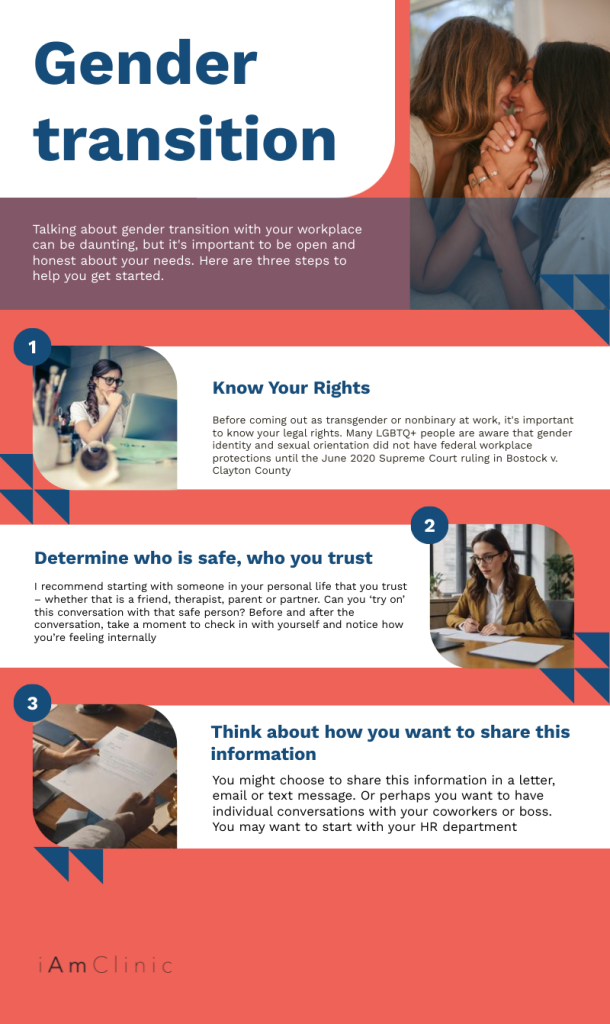Table of Contents
Introduction
Know Your Rights
Determine who is safe, who you trust
Think about how you want to share this information
3 tips for talking with your workplace about gender transition
Disclaimer: this blog does not constitute legal or mental health advice.
Did you know iAmClinic offers career counseling? If you aren’t familiar – career counseling works at the intersection of mental health & challenges in the workplace and/or developing your career. My name is Rae, and in addition to serving as the Clinical Director for iAmClinic, I am also a licensed therapist and certified career counselor. Part of the work I do for iAmClinic is to create resources (like this one!) for folks on how to navigate aspects of their queer and trans identities as they might intersect with their comfort and safety in the workplace. Don’t live in Colorado? I offer career and life coaching for those out of state. Learn more about Lesbian Marriage & Relationship Counseling!
Before we jump in with some tips, please bear in mind that it is always your right to share this information and you get to choose who you do and don’t come out to. There can be very real and pressing concerns on coming out at work, especially in today’s transphobic political climate. I’d encourage you to first step back and think about what might be gained or lost by sharing your authentic self with your workplace. It might be worth talking this through with a trusted friend or support person first.
I also recommend reading our clinician Everett’s story on transitioning in the workplace

Step 1: Know Your Rights
Part of assessing whether or not coming out as trans or non-binary at work is right for you is by first understanding your legal rights. As many trans and queer individuals know, gender identity and sexual orientation weren’t protected rights in the workplace until June 2020, with the Supreme Court ruling Bostock v. Clayton County. The court ruled that the American Civil Rights Acts of 1964 extended to discrimination based on sex. According to the court, “An employer who fires an individual merely for being gay or transgender violates Title VII,” which makes it illegal to do so. Many folks confused this with the Equal Employment Opportunity Law of 1972, which basically just states folks can’t face discrimination in the hiring process itself, not once they are in the job.
So, you can’t legally get fired – but that isn’t enough to make a workplace a safe environment. Part of knowing your rights is also knowing your resources. Many employers will have a dedicated team of human resources, and some even might have an office of diversity, equity and inclusion – in theory these places are designed for staff to go to with concerns. A quick Google search may help you find out what your company resources are. Some great general resources can also be found at Out & Equal and ONE Colorado.
Step 2. Determine who is safe, who you trust.
Whenever we need to have vulnerable conversations, I recommend starting with someone in your personal life that you trust – whether that is a friend, therapist, parent or partner. Can you ‘try on’ this conversation with that safe person? Before and after the conversation, take a moment to check in with yourself and notice how you’re feeling internally. Are you anxious, scared, excited, overwhelmed, relieved? All of those feelings are valid and may come up again even stronger if or when you decide to talk to an employer about it. Check in with yourself a day or two after the conversation and again, notice how you’re feeling about it. It may be helpful to debrief this experience with your therapist, career counselor or coach, if you have one. Learn more about how to Find the Perfect LGBTQIA+ Couples Counselor in Denver.
From there, the next step might be to think about a safe person in your work environment, and again, determine if it feels safe enough to have the conversation with them.
Step 3. Think about how you want to share this information.
As stated before, it is your right to choose who and how this information is shared. Many queer and trans folks have spent much of their life masking parts of themselves to stay safe in their environment. Part of this masking requires the individual to attune to others needs, and so often we can find ourselves attending to others needs instead of our own.
You might choose to share this information in a letter, email or text message. Or perhaps you want to have individual conversations with your coworkers or boss. You may want to start with your HR department. Any or all of these can be great ways if they resonate with you!
In conclusion, however, whenever and to whomever you choose to share your truth with is up to you. Remember you do not need to engage in any medical care to identify as trans, and you don’t have to be ‘out’ to identify as trans. Your identity is valid and important however you choose to show up in the world.


